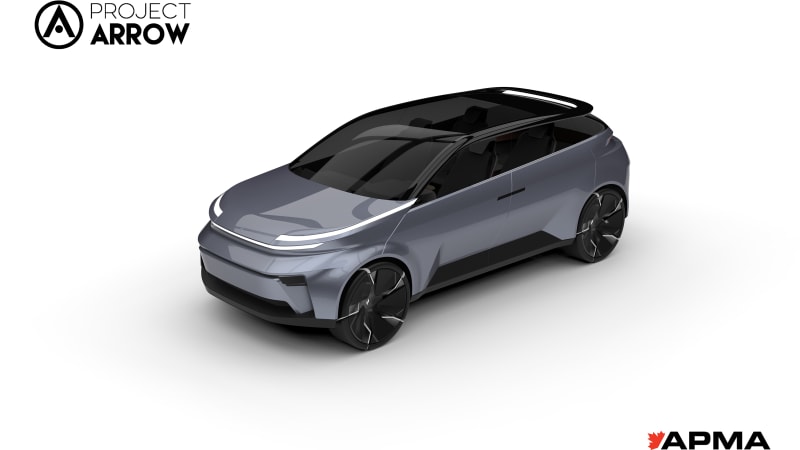A couple of years ago, two execs at the top of Canada’s Automotive Parts Manufacturer’s Association (APMA) sought ways to promote the nation’s automotive industry — a sector the organization said employs more than 100,000 people and sold more than $35 billion in parts in 2018. They settled on the idea of creating a new electric vehicle developed entirely in Canada, from conception to production. At the 2020 Consumer Electronics Show, APMA announced the name of the endeavor: Project Arrow. The plan has a digital avatar now that shows off a virtual design for a battery-electric crossover. If all goes well in 2022, there will be a full-sized prototype ready to go on a roadshow starting with the 2023 Consumer Electronics Show.
The Project Arrow name is a callback to the Avro Canada CF-105 Arrow, a high-speed military interceptor aircraft created in Canada in the late 1950s. The Arrow was a controversial source of national pride; the Canadian government canceled the plane after prototypes had broken several records. The real reasons for the cancelation are still debated.
Four students at Carleton University’s School of Industrial Design in Ottawa penned the exterior and interior based on a concept called “Traction,” working that up into a 360-degree digital design with help from the virtual reality cave at the Institute of Border Logistics. Crossovers from EV startups seem to be coalescing into one archetypal shape, the Project Arrow looking like it’s from the same family tree that sprouted the Fisker Ocean and VinFast e35. This Canadian entry is just as tidy, practical and efficient, sized between the Tesla Model Y and Model X.
The cave is where Project Arrow will be run through simulations of its connected and autonomous tech before those features are make it to the physical vehicle. Before then, engineers are working to make the design as cost-efficient and easy to produce as possible. The team is led by chief engineer Frasier Dunn, formerly head of Aston Martin’s special projects, working on cars like the Vulcan and Valkyrie. Dunn told Automotive News Canada that his team is working on creating the crossover’s body with eight large laser-welded stampings, with enormous magnesium castings forming the front and rear frames, taking inspiration from the Tesla Model Y. Outside, the basic concept of the virtual design will be worked into the prototype without anything superfluous being tacked on. “Even structural elements that are normally hidden away behind plastic trim will be on show and become part of the design,” Dunn said. The sliding front and rear doors, while great for small parking spaces, are almost guaranteed to be set aside for production.
The APMA represents about 90% of Canada’s auto suppliers and has said that more than 400 of its members expressed interest in being a part of Project Arrow. The development team is already examining RFP responses from suppliers to develop the prototype, sorting out agreements and scope-of-work contracts with several dozen. What we expect to see a year from now is a prototype for a electric crossover with sights on competing with the Model Y and Volkswagen ID.4, and that can be made profitably for a cost of between $40,000 to $60,000 at a 60,000-unit annual production.
Canadian companies Martinrea International and NanoXplore formed a joint-venture battery firm called VoltaXplore. That outfit is providing the battery, made up of cylindrical cells using technology developed in part at the Ontario Tech University and Automotive Center of Excellence. Because the team wants to produce an EV suitable for year-round use in Canada, we’re told there will be a new preconditioning and thermal control for the pack, as well as a low-energy heating system for the cabin. The crossover will also make allowances for a hydrogen fuel cell powertrain.
When it is time for tech, the CUV is a disciple of CASE, an acronym for Connected, Autonomous, Shared, and Electric. Developers are targeting what they think will be on the market in 2025, meaning things like SAE Level 3 autonomy and the ability to share the car when not in use. The Canadian government put $5 million CAD ($3.9M U.S.) into the project. Even so, with the APMA financing development, the organization is somewhat constrained by what suppliers can provide based on the program specs and funds. Dunn said, “We’re kind of having to cut the cloth we’re given as opposed to designing the car to exact specifications and everything we would normally do as an OEM.”


